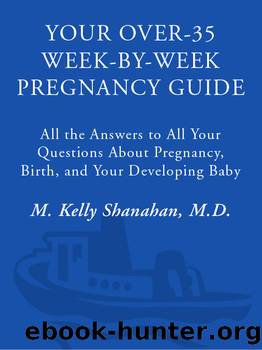Your Over-35 Week-by-Week Pregnancy Guide by Kelly M. Shanahan M.D

Author:Kelly M. Shanahan, M.D. [ M.D., M. Kelly Shanahan]
Language: eng
Format: epub
ISBN: 978-0-307-78178-9
Publisher: Harmony/Rodale
Published: 2011-03-30T00:00:00+00:00
TABLE 25.1
Risk Factors for Placental Abruption
African-American heritage
Age
Cigarette smoking
Cocaine use
High blood pressure, either chronic or pregnancy-induced
Trauma
Uterine fibroid located behind placenta
If the abruption is small, close monitoring of both you and your baby is instituted. Weekly or twice weekly non-stress tests (NST) or biophysical profiles are done (these tests are discussed in detail in week 35) to look for signs the baby is not tolerating this small, chronic abruption. Because the entire area of the placenta is not available for transport of oxygen and nutrients, the babyâs growth may be impaired; ultrasounds are done periodically to make sure the baby is growing properly. If at any time the baby is compromised, is not growing, or there is evidence the abruption is enlarging, early delivery is accomplished.
Another possible cause of bleeding at this stage of pregnancy or beyond is a placenta previa. This is when the placenta partially or totally covers the cervical opening. During labor, as the cervix thins and dilates, there is inevitable bleeding as the placenta tears away; because of this, a cesarean section is necessary when a placenta previa exists at term. Placenta previa is diagnosed by ultrasound. Very early in pregnancy, when the uterus is small, a placenta previa is not uncommonâthere is only so much room, and an edge of the placenta may partially cover the cervix. Most of the time, as the uterus enlarges, the placenta is drawn away from the cervix and follow-up ultrasounds show that the placenta is well away from the cervix; in one study, placenta previa was diagnosed in 25 percent of ultrasounds done at 18 weeks, but by term, only 0.4 percent persisted. Placenta previa complicates 0.3â0.5 percent of all pregnancies. Like many other things weâve discussed in this book, placenta previa becomes more common with increasing ageâand with increasing number of pregnancies. In women over the age of 35, the incidence of placenta previa is 1 percent, increasing to 2 percent after age 40. Other risk factors for placenta previa are listed in table 25.2.
Bleeding, especially painless bleeding (i.e., not associated with contractions), is the classic presentation of a placenta previa, and this bleeding may be torrential. In the past, this was how most previas were first diagnosed; today most are discovered during a routine 20-week ultrasound. Because a placenta previa is so common early in pregnancy, as long as you have not experienced any bleeding, no restriction or modifications of your activities are required at this point. If the placenta previa is still present after 24â26 weeks, however, pelvic rest and avoidance of strenuous activity are advised. Pelvic rest is mandatory because intercourse or even a pelvic exam can cause heavy bleeding. If bleeding occurs, there are two main scenarios: bleeding so heavy that immediate delivery via cesarean section is required, regardless of how premature your baby is; or self-limited bleeding without signs of fetal distress, where delivery can be delayed until your baby is mature. If you have a placenta previa and are discharged home after an episode
Download
This site does not store any files on its server. We only index and link to content provided by other sites. Please contact the content providers to delete copyright contents if any and email us, we'll remove relevant links or contents immediately.
Spare by Prince Harry The Duke of Sussex(5078)
Machine Learning at Scale with H2O by Gregory Keys | David Whiting(4200)
Fairy Tale by Stephen King(3229)
Will by Will Smith(2797)
Hooked: A Dark, Contemporary Romance (Never After Series) by Emily McIntire(2502)
The Bullet Journal Method by Ryder Carroll(2489)
Rationality by Steven Pinker(2295)
Can't Hurt Me: Master Your Mind and Defy the Odds - Clean Edition by David Goggins(2230)
It Starts With Us (It Ends with Us #2) by Colleen Hoover(2206)
Friends, Lovers, and the Big Terrible Thing by Matthew Perry(2126)
The Becoming by Nora Roberts(2095)
Love on the Brain by Ali Hazelwood(1967)
HBR's 10 Must Reads 2022 by Harvard Business Review(1782)
The Strength In Our Scars by Bianca Sparacino(1778)
A Short History of War by Jeremy Black(1764)
Leviathan Falls (The Expanse Book 9) by James S. A. Corey(1651)
515945210 by Unknown(1602)
A Game of Thrones (The Illustrated Edition) by George R. R. Martin(1596)
Bewilderment by Richard Powers(1541)
